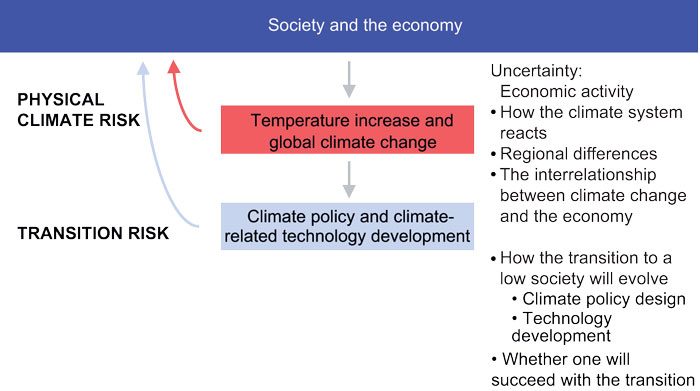3 What we mean by the term climate risk
The term «risk» is associated with uncertainty about events that entail deviations from a planned or envisaged development. These deviations may be negative or positive. A key risk management objective is to withstand negative deviations, and to benefit from the opportunities opened up by positive deviations. Attention will most often be focused on negative deviations, because it will generally be less demanding to adapt to positive than to negative developments and surprises. The magnitude of the risk depends on how large the potential implications are, how likely it is – under available estimates – that these will occur, and the strength of the knowledge supporting the judgment.
Most forms of activity involve having to take risk. Consequently, the challenge is to strike the right balance between the need to create wealth and take risk, on the one hand, and the need to safeguard and protect wealth, on the other hand.
Physical climate risk is risk associated with the implications of physical changes in the environment. Commonly used benchmarks are the current climate or the pre-industrial climate situation. Norway will probably experience increased precipitation, more flooding, more frequent landslips and rising sea level, and these physical changes and the uncertainty associated therewith constitute risk factors. Many of the physical processes happen very slowly, from a human perspective. Even if net global emissions were to be reduced to zero within a short space of time, it may therefore take a very long time for the climate system to arrive at a new equilibrium.
Transition risk is risk associated with the implications of climate policy and technological developments upon transition to a low-emission society. An ambitious climate policy is likely to result in carbon-intensive energy sources such as coal and oil being largely replaced by renewable sources such as sun, water and wind, but we do not quite know when and how this will happen. This has major implications not only for energy producers such as Norway, but for large parts of society and the economy worldwide in coming years. Figure 3.1 provides a diagrammatic illustration of physical risk and transition risk.

Figure 3.1 Climate risk – key relationships
An interrelationship between society and the economy, climate change, as well as climate policy and technological developments. Economic activity causes climate change, which results in feedback effects on society and the economy (physical climate risk) whilst also giving rise to climate policy and technology development, which again result in feedback effects on society and the economy (transition risk).
Source Climate Risk Commission.
Different stakeholders may base their plans on different expectations. The risk outlook will be different for businesses that are planning for a continuation of the fossil-based energy sector than for businesses that are, for example, investing heavily in renewable energy. Many will be exposed to transition risk associated with changes in climate policy, energy policy and prices, as well as technological breakthroughs in the energy markets.
In risk analysis, uncertainty can in many cases be illustrated by way of scenarios. A scenario outlines a possible future development, based on specific mechanisms, assumptions and forces. In other words, it is not a forecast, but a hypothetical construct. Scenarios are intended to illustrate the potential range of future outcomes. An important function of scenarios is to challenge entrenched perceptions about the future, and thereby contribute to more informed decisions and increased resilience.
A resilient system is better placed to respond to external shocks. The vulnerability or resilience of a system denotes its ability to withstand a shock and nonetheless maintain its structure and functions. These shocks often have their origin in external sources and may be beyond the sphere of influence of those affected, but the vulnerability can be reduced (and the resilience increased) through measures that improve their ability to respond to the events. As an example, a municipal administration cannot in practice influence the global mean temperature or precipitation increases, but the municipal administration may have scope for reducing the vulnerability of the municipality – and thus local implications, such as stormwater, flooding and landslips.
The implications of climate-related events will depend on the resilience of society. The implications of events in the wake of global warming will depend not only on the magnitude of the events, but also on the ability of affected stakeholders and society as a whole to withstand such events. The same will apply to implications of a rapid transition to a world of radically reduced demand for fossil fuels. A more resilient society will face lower climate risk. Hence, measures to increase resilience constitute a key strategy for managing climate risk.